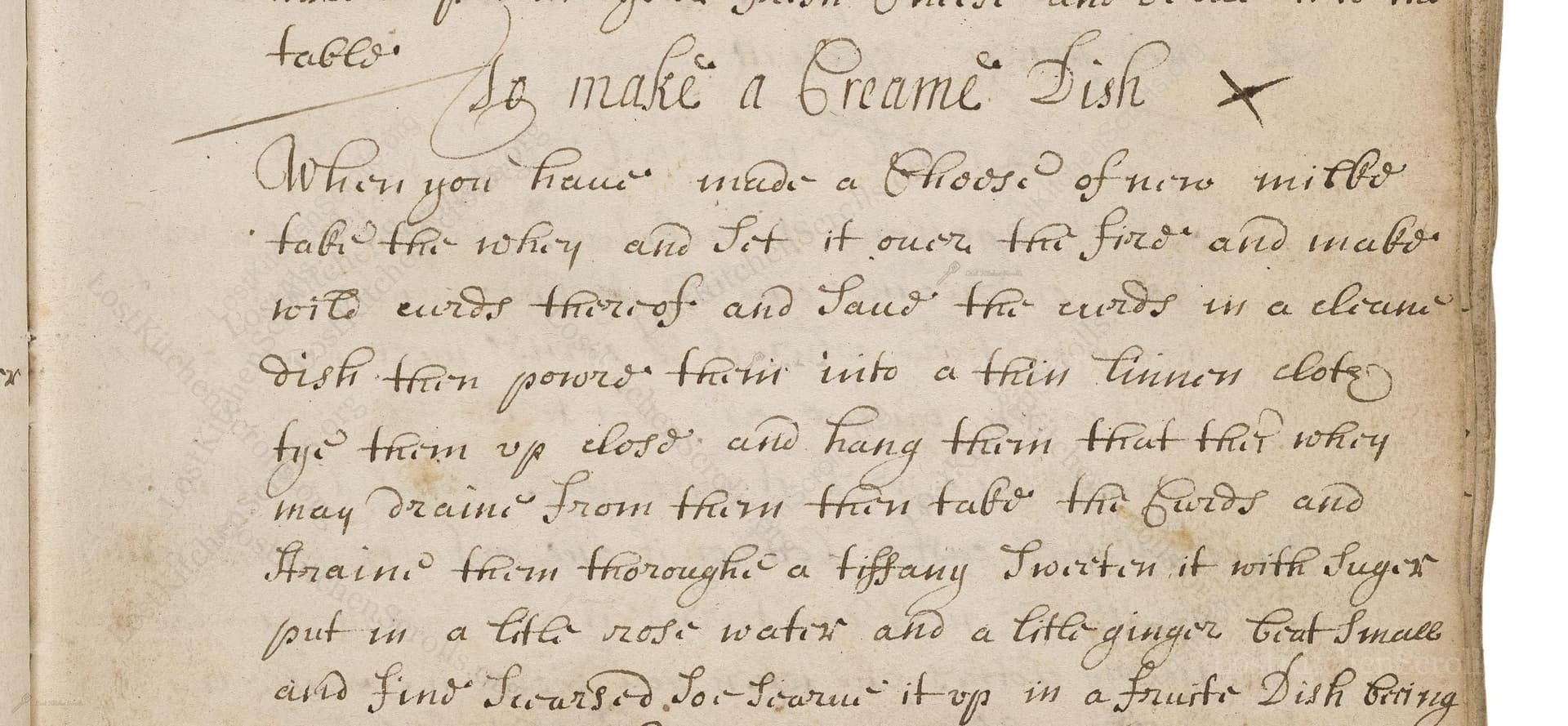So Make A Creame Dish
From the treasured pages of Cookery book of Ann Goodenough
Written by Ann Goodenough

So Make A Creame Dish
"When you have made a Cheese of new milke take the whey and Set it over the fire and make it into curds thereof and Save the curds in a cleane dish then powre them into a thin linnen cloth tye them up close and hang them that the whey may draine from them then take the Curds and draine them thorought a tiffany Lawne with Sugar put in a litle rose water and a litle ginger Cut Smalle and find Swarfed for-Sirrup it up in a fruite dish bring pricked with a knif on the tope"
Note on the Original Text
The recipe is written in the direct, unornamented narrative style common in 18th-century manuscripts, with concise instructions and little in the way of precise measurements. Spelling is often phonetic ('Lawne' for 'lawn,' 'Swarfed for-Sirrup it up' perhaps intending to 'swath or syrup it up'), and punctuation is spare or absent. Such texts assume the reader's kitchen savvy and background knowledge, expecting them to interpret variable ingredient amounts and methods by context and experience.

Title
Cookery book of Ann Goodenough (1738)
You can also click the book image above to peruse the original tome
Writer
Ann Goodenough
Era
1738
Publisher
Unknown
Background
A delightful journey into the kitchens of early 18th-century England, this collection captures the flair and flavors of its time with recipes crafted by the inventive Ann Goodenough. Expect a charming medley of hearty roasts, comforting pies, and time-honored confections, perfect for those wishing to dine as they did in Georgian days.
Kindly made available by
Folger Shakespeare Library
This recipe, originating from the period between 1700 and 1775 and attributed to Ann Goodenough, is a charming example of early English dairy cookery. In an era before refrigeration, fresh milk was a crucial daily staple, and recipes like this showcased the transformation of milk through careful curdling and flavoring. 'So make a Creame Dish' is the type of genteel dessert or light comfort food likely served at a family table, highlighting both the resourcefulness and subtle seasoning preferences of 18th-century English households.

Back in the 18th century, cooks would have used large earthenware pans or copper pots to warm and separate milk. A fine linen cloth, often called 'lawn' or 'tiffany,' was essential for draining and pressing curds. The tied-up bundle would hang from a hook or wooden spoon over a bowl to drain. Finishing touches included fine knives for smoothing or pricking the surface. All mixing would have been done by hand in ceramic or pewter dishes, and serving would be in ornate fruit or sweet dishes, with only the simplest of cutlery.
Prep Time
10 mins
Cook Time
30 mins
Servings
6
We've done our best to adapt this historical recipe for modern kitchens, but some details may still need refinement. We warmly welcome feedback from fellow cooks and culinary historians — your insights support the entire community!
Ingredients
- 2 quarts fresh whole milk (unpasteurized preferred)
- Fine muslin or cheesecloth (as substitute for lawn)
- Caster sugar (2-3 tablespoons, or to taste)
- Rosewater (about 1/2 teaspoon)
- Ground ginger (a pinch; or 1/4 teaspoon very finely chopped preserved ginger if available)
Instructions
- To make a Cream Dish, begin by preparing a simple cheese from about 2 quarts of fresh whole milk (unpasteurized if possible for authenticity).
- Once the curds separate, drain off the whey and reserve it.
- Bring this whey to a gentle simmer over medium heat, stirring occasionally, until it forms small, fine curds.
- Gently scoop out the curds and place them into a clean dish.
- Transfer the curds to a thin linen cloth or muslin, tie it up securely, and hang it over a bowl for at least 1 hour to drain any remaining whey.
- Once well-drained, pass the curds through a fine sieve or clean cloth such as tiffany lawn (substitute: doubled muslin or fine mesh), pressing gently to make a smoother consistency.
- Mix the curds with 2-3 tablespoons of caster sugar, a few drops (about 1/2 teaspoon) rosewater, and a pinch of ground ginger (or finely chopped preserved ginger if available).
- Stir thoroughly, then spoon the mixture into a serving dish, smoothing the top with a knife, and prick the top gently for decoration.
Estimated Calories
150 per serving
Cooking Estimates
You will need about 10 minutes to prepare the ingredients and workspace. The cheese making and draining process takes around 1 hour and 30 minutes. Each serving has about 150 calories. This recipe makes 6 servings.
As noted above, we have made our best effort to translate and adapt this historical recipe for modern kitchens, taking into account ingredients nowadays, cooking techniques, measurements, and so on. However, historical recipes often contain assumptions that require interpretation.
We'd love for anyone to help improve these adaptations. Community contributions are highly welcome. If you have suggestions, corrections, or cooking tips based on your experience with this recipe, please share them below.
Join the Discussion
Rate This Recipe
Dietary Preference
Main Ingredients
Occasions

Den Bockfisch In Einer Fleisch Suppen Zu Kochen
This recipe hails from a German manuscript cookbook compiled in 1696, a time whe...

Die Grieß Nudlen Zumachen
This recipe comes from a rather mysterious manuscript cookbook, penned anonymous...

Ein Boudain
This recipe comes from an anonymous German-language manuscript cookbook from 169...

Ein Gesaltzen Citroni
This recipe, dating from 1696, comes from an extensive anonymous German cookbook...
Browse our complete collection of time-honored recipes



